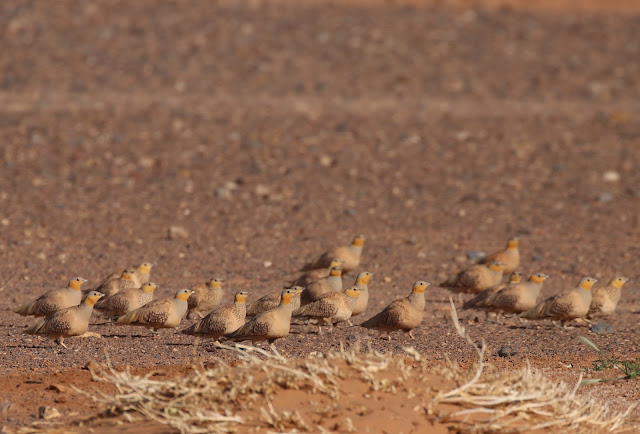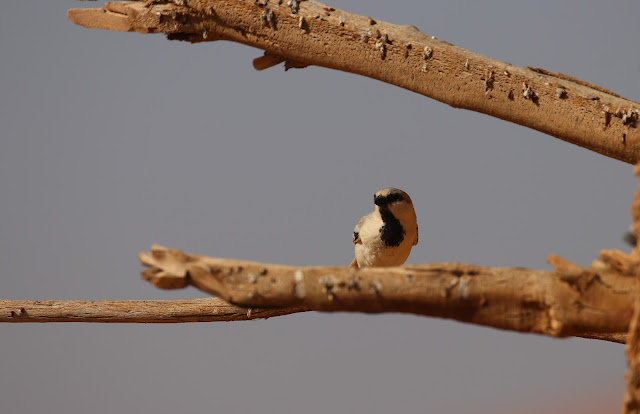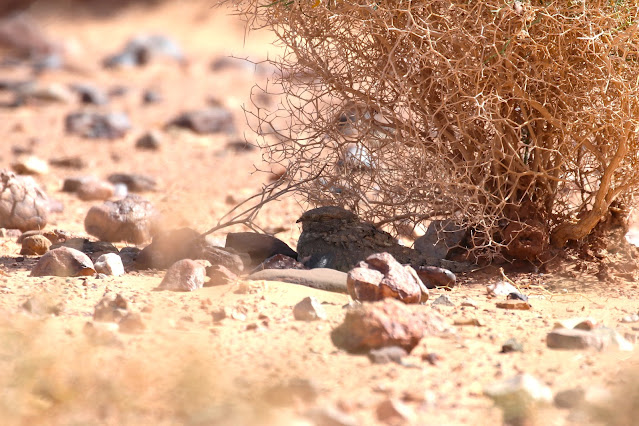Morocco - fun in the desert
Almost exactly a year since the last trip to Morocco but there was unfinished business to attend to. The geographic diversity of the country provides a range of regional specialities and this time, we were hitting the desert.
A long nine hour drive across an arid landscape skillfully avoiding incident while driving out of Marrakech arriving at the Kasbah Erg Chebbi by early evening. The accommodation and food here was incredible as were the views across the desert.
The following morning provided the main focus of the trip - a guided half day tour out into the wilds of the desert for plenty of target species. On-board a 4x4, the guides Otman and Mohammad threw the jeep into the wilderness.
It wasn't long before these targets came into view. A group of sandgrouse were seen in the distance heading toward a watering hole. In no time at all, we were observing a decent group of crowned sandgrouse around a modestly sized watering hole. These birds were thought to have originated their journey from neighbouring Algeria. The mountainous region bordering the countries could be seen from our position.
Such unusual birds and a joy to observe at reasonably close range. The group were exclusively crowned sandgrouse but it wasn't long before a group of spotted sandgrouse flew in.
The landscape was incredible to be a part of, bouncing across the rustic landscape to the next location, a private dwelling with an area of irrigated land where a group of seven fulvous chatterer were boisterously feeding amongst the detritus. Also at this site were a white crowned wheatear, western subalpine warbler, and a male marsh harrier soared overhead.
Onward, we moved further into the desert, passing a few nomadic habitations, canvas tents pitched in relative obscurity, children smiling enjoying the warming days, primitive but comfortingly communal, something we could learn a lot from.
It was one of these areas where a group of birds were present. At least two pairs of desert sparrow, two bar-tailed lark and a hoopoe lark were taking advantage of scraps left behind by the nomadic people. It felt so surreal being here.
Moving on, the drive continued toward an area of arid scrubland, it looked good for something but other than a hoopoe lark, it yielded very little other than small pulses of barn swallow powering northward on their long migration to European breeding sites. A single red-rumped swallow also passed through.

Quickly changing plan, the bird of the trip was in the offing. However, finding it was a challenge. We drove around for a bit, actually it felt like around half an hour. Stopping and starting, the looks on the guides faces didn't really instil any semblance of optimism. This was coupled by a lack of phone signal which temporarily scuppered their plans. The reason was, a local berber had the local knowledge that they needed to find our next target which eventually came to pass when the phones came back into range.
We left the vehicle and wandered over to the sparsely distributed vegetation checking rocks within scant areas of shade. The Egyptian nightjar is a remarkable bird, a species very much on my wish list - and there it was - hunkered down, still and beautifully cryptic. Exceptionally easy to miss, but a total thrill to see.
It was an incredible few hours and while I'm not massively keen on guides, I can't imagine how long it would have taken to find all these incredible birds.
Back at the Kasbah, the rest of the day was quite pedestrian. A couple of desert wheatear and five bar-tailed lark were present nearby along with two western subalpine warbler, two brown-necked raven and a white-crowned wheatear. More barn swallow continued to pass through.

Boumalne Dades was the destination for the following day. A bit of a shorter drive so a couple of stops produced a Magheb lark, two flyover cream-coloured courser, a ruddy shelduck, and plenty of white-crowned wheatear.
I headed north toward the Dades Gorge where a reliable spot yielded a Tristram's warbler which required a bit of patience. Also here was a lovely male blue rock thrush, one rock bunting, one house bunting, one western subalpine warbler, two black wheatear, two crag martin, and three house martin through. Fantastic views were had from here and not a bad one from the restaurant.
Around half hour from Boumalne en route to the Gorge was the curiously named Monkey Finger Viewpoint where below it was an area of cultivated fields with a decent selection of birds that included a woodchat shrike, western bonelli's warbler, three singing nightingale, Cetti's warbler, hoopoe, African chaffinch, chiffchaff, and African blue tit.
That was it - heading back to Marrakech for a final night stopping off at my favourite cafe.
Marrakech was crazy as expected - an amazing city with little swift, house bunting, common bulbul and common swift all available within proximity to Jemaa el Fna.


































Comments
Post a Comment